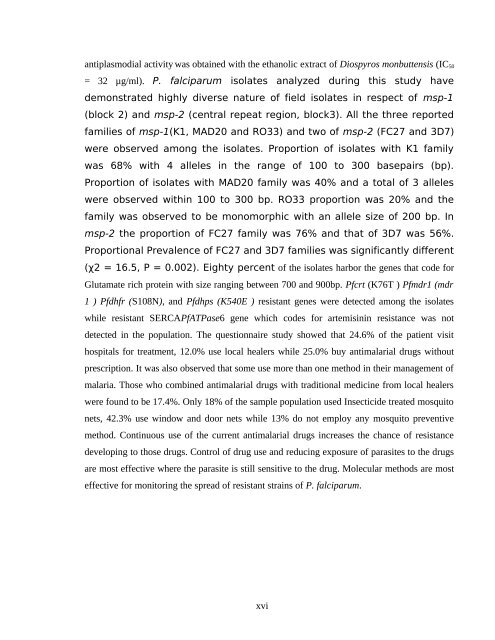in-vitro and molecular studies on the resistance of p - Covenant ...
in-vitro and molecular studies on the resistance of p - Covenant ...
in-vitro and molecular studies on the resistance of p - Covenant ...
You also want an ePaper? Increase the reach of your titles
YUMPU automatically turns print PDFs into web optimized ePapers that Google loves.
antiplasmodial activity was obta<str<strong>on</strong>g>in</str<strong>on</strong>g>ed with <strong>the</strong> ethanolic extract <strong>of</strong> Diospyros m<strong>on</strong>buttensis (IC50<br />
= 32 µg/ml). P. falciparum isolates analyzed dur<str<strong>on</strong>g>in</str<strong>on</strong>g>g this study have<br />
dem<strong>on</strong>strated highly diverse nature <strong>of</strong> field isolates <str<strong>on</strong>g>in</str<strong>on</strong>g> respect <strong>of</strong> msp-1<br />
(block 2) <str<strong>on</strong>g>and</str<strong>on</strong>g> msp-2 (central repeat regi<strong>on</strong>, block3). All <strong>the</strong> three reported<br />
families <strong>of</strong> msp-1(K1, MAD20 <str<strong>on</strong>g>and</str<strong>on</strong>g> RO33) <str<strong>on</strong>g>and</str<strong>on</strong>g> two <strong>of</strong> msp-2 (FC27 <str<strong>on</strong>g>and</str<strong>on</strong>g> 3D7)<br />
were observed am<strong>on</strong>g <strong>the</strong> isolates. Proporti<strong>on</strong> <strong>of</strong> isolates with K1 family<br />
was 68% with 4 alleles <str<strong>on</strong>g>in</str<strong>on</strong>g> <strong>the</strong> range <strong>of</strong> 100 to 300 basepairs (bp).<br />
Proporti<strong>on</strong> <strong>of</strong> isolates with MAD20 family was 40% <str<strong>on</strong>g>and</str<strong>on</strong>g> a total <strong>of</strong> 3 alleles<br />
were observed with<str<strong>on</strong>g>in</str<strong>on</strong>g> 100 to 300 bp. RO33 proporti<strong>on</strong> was 20% <str<strong>on</strong>g>and</str<strong>on</strong>g> <strong>the</strong><br />
family was observed to be m<strong>on</strong>omorphic with an allele size <strong>of</strong> 200 bp. In<br />
msp-2 <strong>the</strong> proporti<strong>on</strong> <strong>of</strong> FC27 family was 76% <str<strong>on</strong>g>and</str<strong>on</strong>g> that <strong>of</strong> 3D7 was 56%.<br />
Proporti<strong>on</strong>al Prevalence <strong>of</strong> FC27 <str<strong>on</strong>g>and</str<strong>on</strong>g> 3D7 families was significantly different<br />
(χ2 = 16.5, P = 0.002). Eighty percent <strong>of</strong> <strong>the</strong> isolates harbor <strong>the</strong> genes that code for<br />
Glutamate rich prote<str<strong>on</strong>g>in</str<strong>on</strong>g> with size rang<str<strong>on</strong>g>in</str<strong>on</strong>g>g between 700 <str<strong>on</strong>g>and</str<strong>on</strong>g> 900bp. Pfcrt (K76T ) Pfmdr1 (mdr<br />
1 ) Pfdhfr (S108N), <str<strong>on</strong>g>and</str<strong>on</strong>g> Pfdhps (K540E ) resistant genes were detected am<strong>on</strong>g <strong>the</strong> isolates<br />
while resistant SERCAPfATPase6 gene which codes for artemis<str<strong>on</strong>g>in</str<strong>on</strong>g><str<strong>on</strong>g>in</str<strong>on</strong>g> <strong>resistance</strong> was not<br />
detected <str<strong>on</strong>g>in</str<strong>on</strong>g> <strong>the</strong> populati<strong>on</strong>. The questi<strong>on</strong>naire study showed that 24.6% <strong>of</strong> <strong>the</strong> patient visit<br />
hospitals for treatment, 12.0% use local healers while 25.0% buy antimalarial drugs without<br />
prescripti<strong>on</strong>. It was also observed that some use more than <strong>on</strong>e method <str<strong>on</strong>g>in</str<strong>on</strong>g> <strong>the</strong>ir management <strong>of</strong><br />
malaria. Those who comb<str<strong>on</strong>g>in</str<strong>on</strong>g>ed antimalarial drugs with traditi<strong>on</strong>al medic<str<strong>on</strong>g>in</str<strong>on</strong>g>e from local healers<br />
were found to be 17.4%. Only 18% <strong>of</strong> <strong>the</strong> sample populati<strong>on</strong> used Insecticide treated mosquito<br />
nets, 42.3% use w<str<strong>on</strong>g>in</str<strong>on</strong>g>dow <str<strong>on</strong>g>and</str<strong>on</strong>g> door nets while 13% do not employ any mosquito preventive<br />
method. C<strong>on</strong>t<str<strong>on</strong>g>in</str<strong>on</strong>g>uous use <strong>of</strong> <strong>the</strong> current antimalarial drugs <str<strong>on</strong>g>in</str<strong>on</strong>g>creases <strong>the</strong> chance <strong>of</strong> <strong>resistance</strong><br />
develop<str<strong>on</strong>g>in</str<strong>on</strong>g>g to those drugs. C<strong>on</strong>trol <strong>of</strong> drug use <str<strong>on</strong>g>and</str<strong>on</strong>g> reduc<str<strong>on</strong>g>in</str<strong>on</strong>g>g exposure <strong>of</strong> parasites to <strong>the</strong> drugs<br />
are most effective where <strong>the</strong> parasite is still sensitive to <strong>the</strong> drug. Molecular methods are most<br />
effective for m<strong>on</strong>itor<str<strong>on</strong>g>in</str<strong>on</strong>g>g <strong>the</strong> spread <strong>of</strong> resistant stra<str<strong>on</strong>g>in</str<strong>on</strong>g>s <strong>of</strong> P. falciparum.<br />
xvi

















